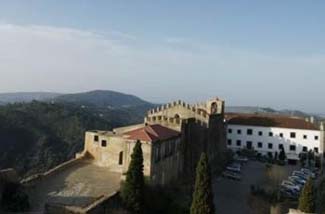
Photos courtesy of Pousada de Palmela
2950-317 Palmela
Tel: ++351 212 351 226
Fax: ++351 212 330 440
Official pousada website
Reserve with Booking.com
23 rooms
Double rooms 110–192 euros
Suites: 154–248 euros
Rates include breakfast, tax,
and service.
Packages available
Open: all year
Palmela is 8 km north of Setúbal on N-379. Buses make the trip from Setúbal every 20 minutes.
On site: massages
Nearby: golf; 4-wheel driving;
hot-air ballooning; canoeing;
bicycling; horseback riding;
hiking; boating; excursions to
Setúbal; Troia Peninsula;
wine tours of Azeitão
The little village of Palmela, with its steep cobblestone streets lined with whitewashed houses, is almost overwhelmed by the imposing, part castle and part monastery complex above. From the castle’s ramparts, a 360-degree view looks out over hills and sea, windmills, and vineyards.
The pousada is installed in part of the old monastery, where public rooms are centered around the original cloisters—now with glassed-in arches. Tapestries and a plethora of potted plants soften the austerity. Long marble-floored hallways with vaulted ceilings lead to comfortable lounge areas furnished with leather sofas and armchairs.
Upstairs, the spacious guest rooms feature red tile floors and hand-painted tile baths. Rough-woven fabrics and leather and carved furnishings contrast pleasantly with the whitewashed and natural stone walls. All but two rooms have views looking out toward Setúbal.
Operating in the former refectory (the pulpit where prayers were once read still stands), the dining room is extremely popular with locals who come from as far away as Lisbon. Venison, wild boar, and a good selection of seafood are on the traditional Portuguese menu.
![]() The castle of Palmela is a National Monument.
The castle of Palmela is a National Monument.
![]() Outstanding views, and on clear days you can see all the way to Lisbon.
Outstanding views, and on clear days you can see all the way to Lisbon.